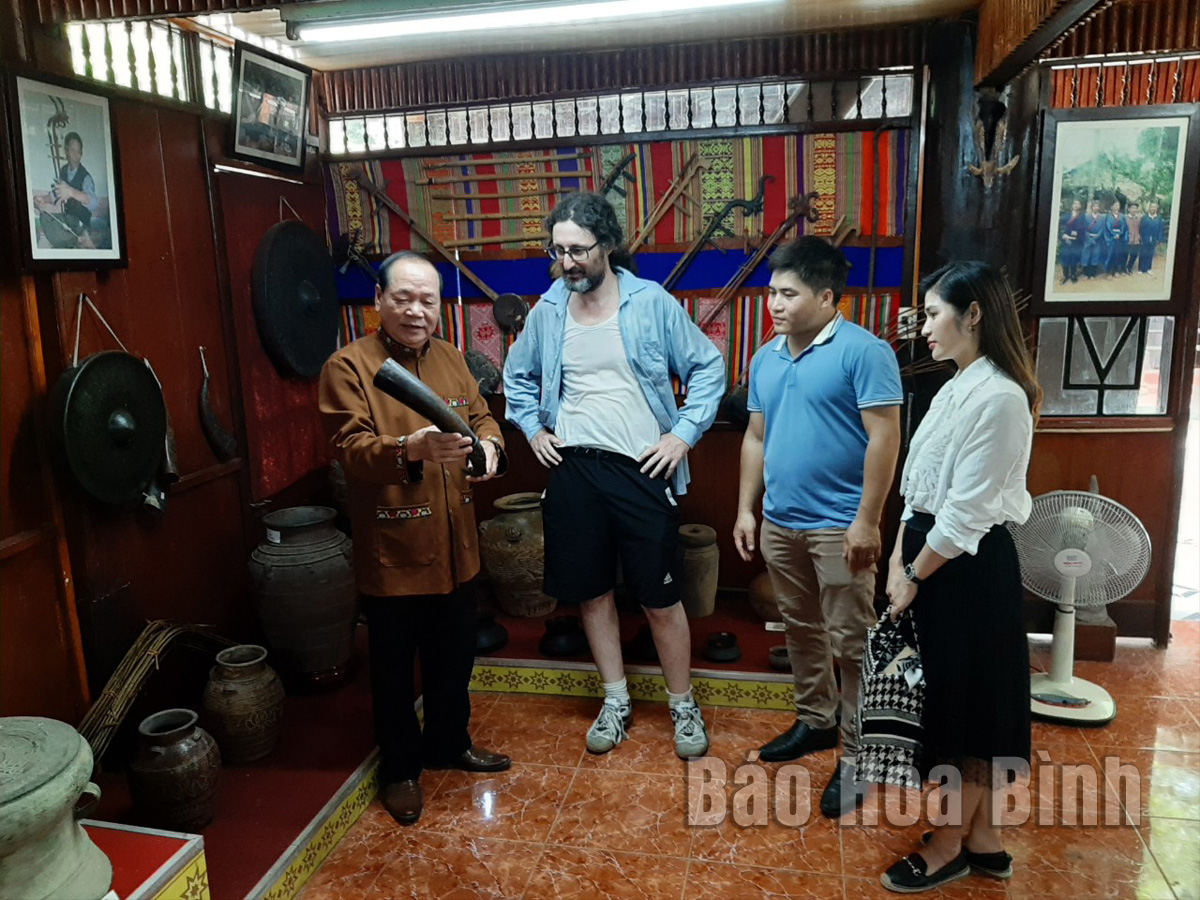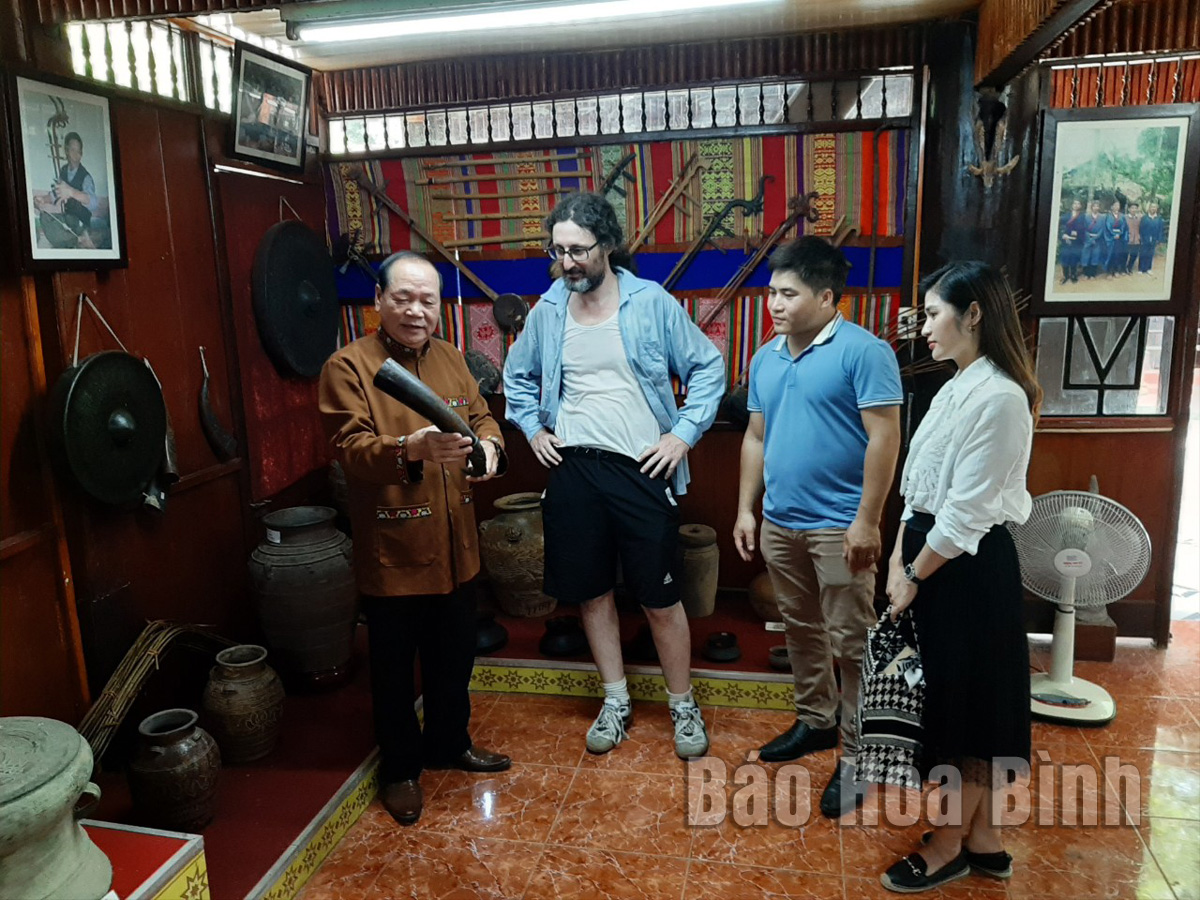
(HBO) – Bui Thanh Binh, Director of the Muong Cultural Heritage Museum in Thai Binh ward of Hoa Binh city (Hoa Binh province), has been spending decades helping preserve the Muong ethnic group’s culture.
Bui Thanh Binh introducing tools displayed at the Muong Cultural Heritage
Museum in Thai Binh ward of Hoa Binh city to visitors.
Binh said when working as a tour guide at the
Hoa Binh travel company in 1985, he realised that foreign tourists preferred
visiting mountainous and remote areas to explore ethnic groups’ culture. Born
in the Muong Dong area – one of the cradles of the Muong culture, he has
nurtured a desire to help uphold the cultural heritage of the Muong people
since their culture not only is diverse but also boasts high artistic value.
In 1985 - the first year of his efforts, Binh
spent his modest salary collecting household utensils such as a basin, a frying
pan, and several bronze food trays from rural residents. From 1988 to 1998, he
collected a number of ceramic and bronze items, rice milling utensils, and
belongings of shamans. About 5,000 - 6,000 unique objects reflecting the life
of Muong people have come to his possession so far.
Introducing the Muong Cultural Heritage Museum,
Binh showed visitors six stilt houses deeply imbued with Muong people’s
cultural identity. The houses are located on a hill covering about 4,000 square
metres.
Among them, a stilt house of a Muong herbalist
contains many precious objects like an altar, a set of items used in betel
chewing, jewellery, hunting and foraging tools, bone and horn handicrafts,
swords, and seals. Meanwhile, the farmer house boasts such items as rice
milling utensils, wine jars, a wooden weaving loom, and men and women’s
outfits, helping visits gain an insight into the life of Muong people.
At a stilt house showing the ethnic group’s
cuisine, Binh said wild vegetable, five-colour steamed sticky rice, grilled and
steamed fish, and roasted pork are among the dishes winning tourists’ hearts.
Over the last more than 10 years, the Muong
Cultural Heritage Museum has welcomed thousands of tourists from across Vietnam
and other countries.
Apart from searching for and collecting
antiquities of the Muong culture, Binh has also invested efforts in maintaining
and popularising the group’s folk songs, especially gong pieces – a
long-standing part of the Muong people’s life.
The artisan has taught the Muong gong playing
skills and folk music to learners from various localities, from Hoa Binh,
Hanoi, Phu Tho, Thanh Hoa in the north to Lam Dong and Dak Lak provinces in the
Central Highlands. He is also the head of the Muong village’s artisan group at
the Vietnam National Village for Ethnic Culture and Tourism in Hanoi’s Son Tay
town./.
Gongs hold a special place in the cultural and spiritual life of the Muong ethnic people in Hoa Binh province. More than musical instruments, they are an indispensable part of community rituals and collective memory, echoing through generations as a spiritual thread linking the past, present, and future.
Preserving and promoting the cultural values of the Muong ethnic group has become an urgent task in the current context, as many traditional values face the risk of fading away. This effort requires not only protecting the cultural identity but also eliminating outdated customs and developing a modern cultural lifestyle, contributing to sustainable values for the Muong community in Hoa Binh province.
The Muong ethnic culture, deeply rooted in Vietnam’s mountainous north, continues to be preserved and revitalised by dedicated individuals and communities determined to safeguard their ancestral identity.
The Muong group is one of the largest ethnic minorities in Vietnam, primarily found in Hoa Binh province. The Muong people in Hoa Binh boast a rich and diverse cultural treasure that reflects the unique identity of this ethnic group. Accounting for over 63% of the province's population, they have created and preserved numerous distinctive cultural values, contributing to their unique identity. Their cultural heritage is an invaluable asset, at the heart of their national identity, and represents a vibrant spiritual life that must be preserved and promoted in today’s modern world.
For generations, the ethnic communities of Hoa Binh province, particularly the Muong people, have preserved vibrant festivals deeply intertwined with the region’s geography, nature, and social traditions. These celebrations enrich Hoa Binh’s spiritual life and cultural identity, reflecting both folk beliefs and the intermingling of ethnic customs. Many of these festivals have endured the test of time, passed down through generations and continuing to thrive today. Among them, the Khai Ha (Going Down to the Field) festival stands out as one of the most significant events of the Muong ethnic group.
Muong calendar, known as sach doi, is an ancient folk knowledge system developed through observations of the movement of the pleiades star. This unique calendar consists of 12 bamboo sticks, each representing a lunar month. Specific days within each month are marked with distinct symbols, guiding locals in determining auspicious and inauspicious days for important activities.



